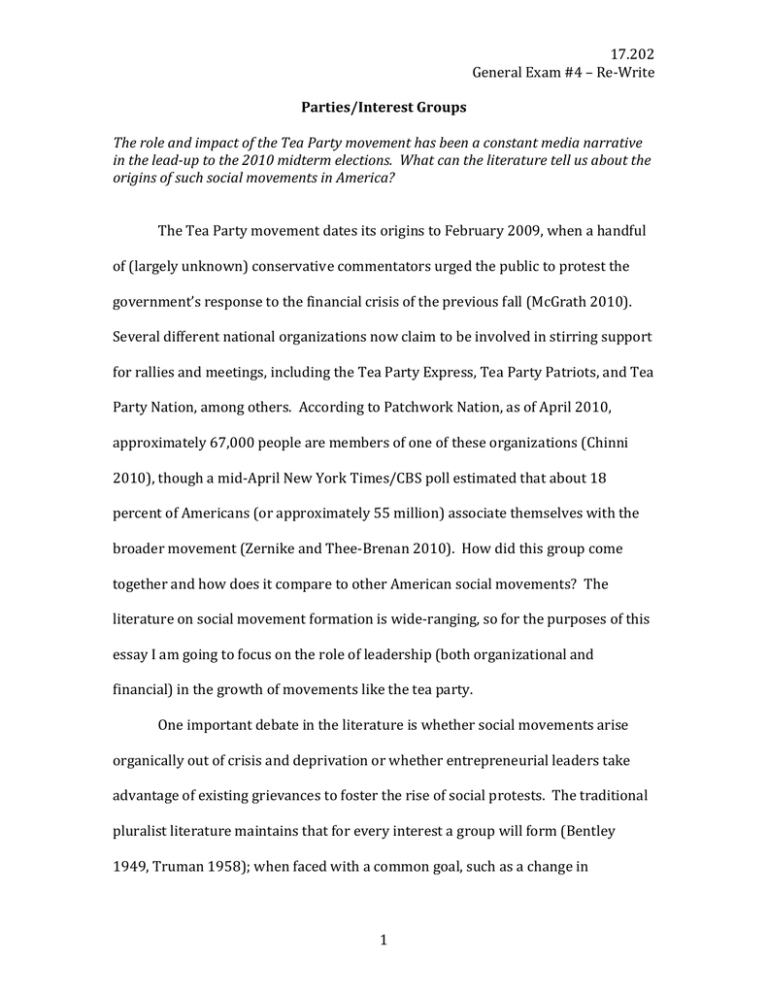17.202 General Exam #4 – Re-Write Parties/Interest Groups
advertisement

17.202 General Exam #4 – Re-Write Parties/Interest Groups The role and impact of the Tea Party movement has been a constant media narrative in the lead-up to the 2010 midterm elections. What can the literature tell us about the origins of such social movements in America? The Tea Party movement dates its origins to February 2009, when a handful of (largely unknown) conservative commentators urged the public to protest the government’s response to the financial crisis of the previous fall (McGrath 2010). Several different national organizations now claim to be involved in stirring support for rallies and meetings, including the Tea Party Express, Tea Party Patriots, and Tea Party Nation, among others. According to Patchwork Nation, as of April 2010, approximately 67,000 people are members of one of these organizations (Chinni 2010), though a mid-April New York Times/CBS poll estimated that about 18 percent of Americans (or approximately 55 million) associate themselves with the broader movement (Zernike and Thee-Brenan 2010). How did this group come together and how does it compare to other American social movements? The literature on social movement formation is wide-ranging, so for the purposes of this essay I am going to focus on the role of leadership (both organizational and financial) in the growth of movements like the tea party. One important debate in the literature is whether social movements arise organically out of crisis and deprivation or whether entrepreneurial leaders take advantage of existing grievances to foster the rise of social protests. The traditional pluralist literature maintains that for every interest a group will form (Bentley 1949, Truman 1958); when faced with a common goal, such as a change in 1 17.202 General Exam #4 – Re-Write government policy, interested parties will come together to make their case. Although this view has largely fallen from favor in modern political science, more recent authors maintain that organizational activity may arise spontaneously out of crisis. In the 53 social movements studied by Gamson (1975), 39 were initiated during “turbulent” times, such as the Great Depression (pg 112).1 Piven and Cloward (1977; pg 3-4) claim that social protest emerges when the political system loses legitimacy and disaffected people begin to believe they can make a change by asserting their rights. The authors note that such spontaneous social movements are fostered when the “routines of daily life”—which maintain the social and political system—are broken (pg 10). This certainly comports with the foundations of the tea party movement, coming on the heels of the worst financial crisis since the 1930s and leading to record levels of unemployment. On the other hand, many authors suggest that crisis or increasing deprivation is not necessary to the formation of social groups (Jenkins 1983). McCarthy and Zald (1977) cite several studies showing a relatively weak connection between actual or perceived deprivation and the formation of social movements. Instead, entrepreneurial leaders “prospect” for issues that can mobilize a group (Diani 1996). Salisbury (1969) develops an economic model of this effort, where entrepreneurs offer a package of benefits for potential group members in exchange for joining the movement; this offer may be in response to a perceived grievance but need not be. It is not clear that the tea party was initiated by an entrepreneurial leader, but Gamson does not claim these new interest groups were spontaneously formed, but the statistic is, I believe, important to note. 1 2 17.202 General Exam #4 – Re-Write certainly leaders have subsequently arisen that can fit the resource mobilization model. For example, the private (and costly) Tea Party Nation conference in February may be considered an entrepreneurial effort to capture an otherwise spontaneous movement. Another area of disagreement in the literature is the role of financial resources: some research notes the role selective benefits in internally funding such movements, while other research highlights the importance of patrons in starting and maintaining interest groups. Olson (1965) is one of the first to observe the importance of selective benefits in both forming groups as well as ensuring funding for group efforts; in fact, he claims that without such benefits, collective action groups are unlikely to exist. As mentioned above, Salisbury (1969) continues Olson’s argument, theorizing that leaders put together a package of material, solidarity, and expressive benefits that are offered for the price of membership.2 The other side of this argument looks at the role of financial patrons in initiating social movements. McCarthy and Zald (1977) identify “conscience constituents,” or supporters of a movement that do not stand to benefit from the collective good sought. These patrons typically help fund organizations that lack internal resources, but seek to accomplish goals perceived as worthy.3 Walker (1983) finds strong support for the role of patrons in supporting citizen’s groups. Eighty-nine percent of The “price” of membership need not be monetary; it can be as simple as signing a petition or, in other cases, more complex and expensive. 2 3 Olson also sees a role for individual beneficiaries, such as when the individual share of a potential collective benefit is more valuable to a patron than the cost of providing such a benefit to all. However, Olson believes such patrons are only likely to arise in small groups; in larger groups, the costs of a collective benefit are probably too great (34). Although most of his discussion concerns patrons internal to an interest group, he notes that purposive benefits may inspire outsiders to rationally contribute to a cause (64). 3 17.202 General Exam #4 – Re-Write these groups received aid from an outside source to start their operations, and 43 percent of citizen group revenue in 1980 stemmed from nonmember contributions (pg 398-400). Although the funding for tea party groups is not yet clear, it seems as though much of the support comes from patrons rather than members. At a local level, there are likely limited costs and some are subsidized by national organizations, such as the Tea Party Patriots.4 There is speculation that national organizations, particularly the Tea Party Patriots, are funded by Republican think tanks and lobbying firms, such as FreedomWorks, though there is limited evidence to support (or refute) such claims (McGrath 2010). A final fault line in the social movement literature is whether groups benefit from organization and centralization. Piven and Cloward (1979) believe that organization is antithetical to the success of social movements. In their view, leadership spends time in organizational efforts for group maintenance, while their time could be better spent pursuing the specific goals of the group. Moreover, organized leadership efforts often result in the “channeling” of concerns into “normal politics,” which may not serve the group’s interest (pg xi-xii). On a related note, McCarthy and Zald (1977) note that federated group, with local chapters, can be formed more quickly than national movements seeking “isolated constituents,” in part due to the ability to leverage pre-existing social groups. Federation also lends stability to social movements, as isolated constituents are more ephemerally tied to the cause (pg 1228). On the other hand, Gamson (1975) proposed that successful social movements tended to be more bureaucratized and centralized (pg 94), in part 4 See http://www.teapartypatriots.org/AboutUs.aspx. 4 17.202 General Exam #4 – Re-Write because centralization may prevent the splintering of a group into competing factions (though, interestingly, bureaucratization does not prevent factionalization; pg 104-105). Staggenborg (1988) echoed Gamson’s argument, finding that “formalized” groups can engage in necessary activities, such as lobbying and applying for support from foundations; they are also able to maintain coordination with other similar social movement organizations. The tea party is certainly federated, with thousands of local groups only loosely affiliated with any national organization.5 It likely also benefits from pre-existing social ties, such as former members of the Reform Party or previously-mobilized retiree groups.6 Campbell finds that senior citizens are highly mobilized by political parties, even lower income seniors who are politically active with regard to Social Security funding. To the extent that these groups are central the tea party movement, their previous mobilization can only be an advantage. The origins of the tea party movement combine a complex mixture of organizational and financial leadership and loosely-tied local groups. As Jenkins (1983) notes, Zald and Ash (1966) contend that different organizational structures support different group goals; Jenkins also theorizes that most social movements likely fall “somewhere between” the bureaucratic and decentralized models (pg A New York Times editorial referred to the tea party movement as “a Frankenstein movement – an odd collection of factions, loosely stitched together, where the head, to the extent that it exists, fails to control the body” (Blow 2010). 5 6 It is not entirely clear that the tea party movement is driven by either of these groups, however. Schaller (2010) of 538 and Balz (2010) of the Washington Post both compare the tea party to Perot’s Reform Party and find some similarities, but both conclude that there are important differences between the groups, notably the overwhelming support for the Republican party among tea party adherants. The New York Times/CBS poll found that tea party supporters tend to be over 45 (Zernike and Thee-Brenan 2010), but an earlier USA Today/Gallup poll reported that tea party supporters are only slightly more likely than all U.S. adults to be over 50 or retired (Saad 2010). 5 17.202 General Exam #4 – Re-Write 542). Entrepreneurial leaders and financial patrons have played only a moderate role in the tea party movement thus far—they were not largely involved in the origins of the movement, but seem to be taking an increasing role as time progresses. How these trends progress and influence the success of the tea party remains to be seen. References Balz, Dan. April 18, 2010. “Don’t be too quick to mistake tea party for Perot movement.” Washington Post. Bentley, Arthur. 1949. The Process of Government. Evanston, IL: Principia Press. Blow, Charles M. May 8, 2010. “Trying to Outrun Race.” The New York Times. Chinni, Dante. April 21, 2010. “Tea party: How big is it, and where its it based?” Patchwork Nation (http://patchworknation.csmonitor.com). Diani, Mario. 1996. “Linking mobilization frames and political opportunities: insights from regional populism in Italy.” American Sociological Review. 61(6):1053–1069. Gamson, William A. 1990 (1975). The Strategy of Social Protest. Belmont, CA: Wadsworth. Jenkins, J. Craig. 1983. “Resource Mobilization Theory and the Study of Social Movements.” Annual Review of Sociology. 9: 527-553. McCarthy, John D. and Mayer N. Zald. 1977. “Resource mobilization and social movements: a partial theory.” American Journal of Sociology. 82:1212–1241. McGrath, Ben. February 1, 2010. “The Movement: The rise of Tea Party activism.” The New Yorker. Olson, Mancur. 1965. The Logic of Collective Action: Public Goods and the Theory of Groups. Cambridge, MA: Harvard University Press. Piven, Frances F, and Richard Cloward. 1978. Poor People’s Movements: Why They Succeed, How They Fail. New York: Vintage. Salisbury, Robert H. 1969. “An Exchange Theory of Interest Groups.” Midwest Journal of Political Science. 13(1): 1-32. Schaller, Tom. April 19, 2010. “How Similar Are Tea Party and Perot Movements?” FiveThirtyEight.com. Staggenborg, Suzanne. 1988. “The Consequences of Professionalization and Formalization in the Pro-Choice Movement.” American Sociological Review. 53(4): 585-605. Truman, David B. 1958. The Governmental Process. New York: Alfred A. Knopf. Zald, Mayer N. and Roberta Ash. 1966. “Social movement organizations: growth, decay and change.” Social Forces. 44:327–341. 6 17.202 General Exam #4 – Re-Write Zernike, Kate and Megan Thee-Brenan. April 14, 2010. “Poll Finds Tea Party Backers Wealthier and More Educated.” The New York Times. 7 MIT OpenCourseWare http://ocw.mit.edu 17.202 Graduate Seminar in American Politics II Spring 2010 For information about citing these materials or our Terms of Use, visit: http://ocw.mit.edu/terms.






